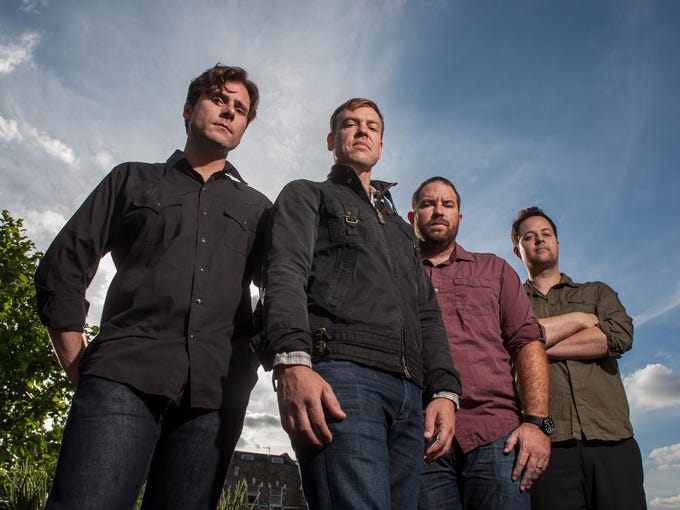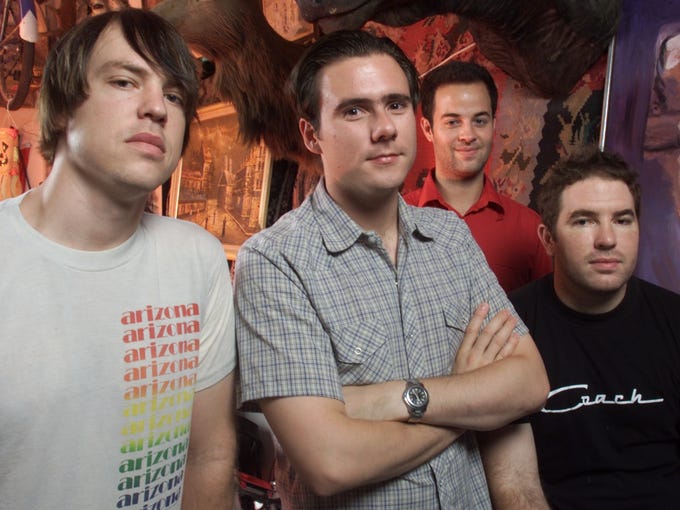Jim Adkins is calling from Cleveland, where Jimmy Eat World are about to play Jacobs Pavilion on a co-headlining tour with Third Eye Blind. It’s Jimmy Eat World’s 25th summer on the road.
“It’s surprising,” Adkins says of the fact that he’s spending that 25th summer touring amphitheaters. “And definitely not expected. I mean, nothing is expected, really. That’s the mindset that we live in. If you’re not expecting anything, whatever happens is a nice surprise.”
Adkins and drummer Zach Lind, a friend since preschool, were seniors at Mountain View High School when they formed the group in 1993 with guitarist Tom Linton and founding bassist Mitch Porter, both of whom had gone to Westwood High.
“Somewhere around junior high when we all got into punk rock and started playing our respective instruments, it wasn’t hard to find people,” the singer-guitarist recalls. “I mean, you found everybody who liked what you liked pretty easily because there wasn’t a lot of you. And back in those days, playing an instrument or playing in a band was definitely not all that cool.”
When he first started playing guitar, Adkins says, “it was more about the metal, more virtuoso-type players. Then, at some point, I realized ‘There’s no way I’ll ever do that.’ So it just morphed into a quest for musicianship over technical prowess.”
That was part of what drew him to punk.
The other part?
“I was, like, 14,” he says, with a laugh. “You have a lot of things happening when you’re 14, 15, 16 that you need an outlet for, and punk rock seemed to be the natural fit for that.”
At first, like any young musicians, Adkins figures they sounded a lot like the sum of their record collections.
“I remember at our first jams,” he says, “we’d just play Propagandhi, Face to Face and NOFX, things more like that. We listened to a lot of faster but melodic kind of things, rather than just pure abrasion or pure aggression. After a few years, we just kind of got more in tune with the way each other played. And you sort of pick up on what your strengths and weaknesses are gonna be the longer that you do something. So you’ve just gotta sort of work through that. After a certain amount of time, you know where you can lean in to use a strength. You also realize where you can push to get past something that might be uncomfortable.”
How Jimmy Eat World got their name
Although Adkins eventually would become their primary lead vocalist, he’s Jim, not Jimmy. The band name is based on a painting done by one of Linton’s younger brothers — who were fighting.
As Adkins once told The Republic, “The older brother, Jim, apparently won against Ed. This must have been when they were pretty young. Like, under 8. In an attempt to get back at him, Ed drew a picture of Jim and a globe in his mouth. He wrote the caption ‘jimmy eat world’ to insult him, saying he was so fat he could eat the world.”
As they started playing out, Adkins says, “There were so few people doing it. I feel like there was there wasn’t really much of a scene to break into because we were promoting our own shows. Or we were trying to get on gigs with friends of ours.”
They were too young, he says, “to really be invited to the thing that was happening with the Tempe people, and we weren’t even on the radar of what was happening in Phoenix. Not that there was a ton of stuff happening in Phoenix. So we just kind of broke in on ourselves.”
There were a few things happening, he says. “There was always the all-ages art space that was open for, like, seven months at a time before it would get shut down by the police. So we would play those places.”
A 19-year-old with a major-label deal
They’d managed to generate sufficient buzz on the strength of a self-titled debut released in 1994 on a Phoenix-based imprint called Wooden Tree Records that Capitol Records offered them a deal in 1995. They signed just after parting ways with Porter. His replacement — Linton’s friend Rick Burch — has been their bassist ever since.
Asked if it felt like things were moving fast at that point, Adkins, who was 19 when they signed, says, “Well, we had no idea what fast was or what normal was.”
He laughs, then says, “We started working with Capitol Records in 1995. And for me to say that out loud? Or for someone to read that on paper? The reality of that is going to be much different than whatever you might think it is.”
Their first record on Capitol, “Static Prevails,” hit the streets in the summer of 1996. And yet, they were still being booked by their drummer.
“We were doing these month-and-a-half-long tours playing for nobody with a record out on Capitol,” Adkins recalls with a laugh. “Playing punk rock festivals with 40 bands and no one getting paid. And there’d be 20 people in attendance.”
It didn’t bother them. They were kids. And as Adkins recalls their mindset at the time, “We had no illusions about anything. We weren’t expecting much from Capitol. We just figured at worst, we’re gonna have some funny stories about going to California.”
It’s an attitude he feels was based in part on having come up through the scene in Arizona.
“There’s a lot of people doing great work,” Adkins says. “But it’s always been really hard to rally that critical support to break out. The good news is you can do whatever you want because no one cares. The bad news is no one cares.”
It’s not that Adkins is complaining.
“It’s totally cool,” he says. “It’s the kind of place where if you want to put a specific type of project together, you totally can, and there’s great people that will help you do it. The bad news is — you’d better be OK with the reward of that being just seeing it happen. Because anything beyond that is not guaranteed to you. And we kind of approached the thing with the record label, and everything, with that mindset.”
When Jimmy Eat World found their voice
In retrospect, Adkins thinks Jimmy Eat World were “still figuring out some things” in the “Static Prevails” era. It was on “Clarity,” their second Capitol release, that Adkins says, “I feel like we were really exploring a voice that was ours.”
Although the album failed to chart in 1999, it went on to be viewed as something of a seminal recording, one of two albums by Jimmy Eat World to make Rolling Stone magazine’s countdown of the 40 Greatest Emo Albums of All Time.
LOCAL FAVES: Phoenix music-scene people pick favorite Jimmy Eat World songs
Not that Adkins would’ve used that term to sum up “Clarity” or any other album they’ve released; although he will say, “I totally understand people’s need to quantify the musical experience, to have some verbal way to talk about it.”
It was after being dropped by Capitol that Adkins and his bandmates chose to come up with the cash to cut their next move, “Bleed American,” which went on to become their mainstream breakthrough after they signed their second major-label deal with DreamWorks – thanks in large part to the airplay they were getting on a single called “The Middle.”
Despite a title change after Sept. 11 for fear that “Bleed American” could be misread as “Bleed, American,” the now-self-titled album was certified platinum in mid-2002.
“I don’t think any of us really appreciated it or realized what was happening until maybe a couple years after all that had happened,” Adkins says of the album’s success.
“I mean, from our perspective, the entire thing leading up to even, like, the ‘Futures’ album was all just one kind of upward trajectory. Like there’d be a few more people at a show. Or we’d get offered a better opening slot to somebody. And when ‘Bleed American’ was doing really well and ‘The Middle’ was going off, it was like, ‘OK; things are crazier. There’s more people here. I guess we’re playing. Cool.'”
It was maybe a few months after they stopped touring on the album that the reality of what had happened really hit him.
“When you’re right in the middle of it,” Adkins says, “you don’t have time to really put things into a true larger-picture perspective because you’ve got to focus on what you’re doing.”
‘We were all so proud of them’
Jeremiah Gratza was 19 when “Bleed American” came out. By that point, he already had “Can you still feel the butterflies,” a favorite line from “For Me This is Heaven,” a track from the “Clarity” album, tattooed on his chest.
Today, he’s director of operations at Stateside Presents.
As Gratza recalls the excitement on the local scene when “Bleed American” began to break, “They were an integral part of growing up in Arizona to me. I remember going to Nita’s Hideaway in high school to see them film the music video for ‘Bleed American.’ We were all so proud of them.”
“The Middle” peaked at No. 5 on Billboard’s Hot 100, also topping the magazine’s Alternative Songs chart. In 2009, by which point “Bleed American” had reclaimed its original title, “The Middle” was covered by Prince at his post-Oscar bash at the Avalon Ballroom in what a reporter form Rolling Stone called a “true-to-the-original” rendition. Seven years later, Taylor Swift lip-synced the song in an Apple Music ad.
“It’s kind of nuts,” Adkins says with a laugh. “I mean, hearing that Prince had covered it at whatever Grammy after-party he did or Taylor Swift hand-picking it to use for an Apple commercial? It’s like what?! What is that? I don’t know. I still freak out anytime I hear ‘The Middle’ or anything we’ve done, like, on the radio.”
They’ve had plenty of songs on the radio since then. This includes six more Top 10 entries on Billboard’s Alternative Songs chart, from the “Bleed American” highlight “Sweetness” through the chart-topping “Pain,” from 2004’s “Futures,” to “Sure and Certain,” from their latest album, 2016’s “Integrity Blues.”
They’re also consistently being celebrated in lists.
In Rolling Stone magazine’s countdown of the 40 Greatest Emo Albums of All Time, “Clarity” was hailed as “a cult classic,” ranked at No. 13. “Bleed American” was four spots higher, hailed as “the album that propelled them from playing with underground bands like Mineral and Christie Front Drive to full-blown mainstream success — platinum certification, MTV play and a Top 10 single.”
They were also named the 20th most influential band of the years 1986-2015 in Alternative Press.
“Few bands can claim one iconic album,” the entry read. “Jimmy Eat World have released no fewer than three over their career. From the emo landmark ‘Clarity’ through the mainstream breakthrough ‘Bleed American’ to the brooding ‘Futures,’ this Arizona quartet are the rare breed of band who are both revered and still relevant more than two decades in.”
Success — and staying in the Valley
Adkins is too well-adjusted — and humble — to place much stock in accolades as high as that, although he has learned to appreciate them.
“It’s hard for me to really agree about our significance in the role of the advancement of music,” he says, with a laugh. “I mean, what kind of (expletive) would you be to be like, ‘Oh yeah, totally. We’re the godfathers of this scene.’ It’s not at all how I identify. But I guess it is a big compliment that other people might see it that way. I’ve gotten better about accepting compliments as time has gone on. I’m really bad at that. But there’s other people I look up to. I know how that feels. So I just have to accept that when we’re the object of that for somebody else, that’s, like, a big deal. And I try to appreciate that.”
It’s been three years since “Integrity Blues,” and Adkins says there is new music on the way.
“I don’t have a release date I can tell you, so I’m hesitant to really get into that until that happens,” he says. “I don’t want to say, ‘Oh, we’ve got a new record’ and then it’s not happening until next year or whatever. But I’m almost positive it’s going to be in the fall.”
As to what fans can expect from the album, Adkins says, “Judging from the past things that we’ve done, you can kind of get a guess who we are. There’s definitely a more guitar-based rock thing that we do. There’s also a more textural, moody, possibly more mellow thing we do. I think the album is definitely gonna have all sides of what we do, but I feel it’s a lot more weighted on the sound of a four-piece band rocking.”
This will be Jimmy Eat World’s 10th studio album. Every album they’ve released since 2002, when “Bleed American” went platinum, has gone Top 20 on the U.S. album chart while spawning at least one alternative radio hit.
And through it all, they’ve stayed here in the Valley.
“Where else are we gonna go?” Adkins says, with a laugh. “Like, are you gonna go to LA? What are you gonna do in LA? Do you know how many people are in LA? Do you know how many bands there are trying to make it? It’s like, we can do what we want in Phoenix. We know people, and our family’s there. Our friends are there. We travel so much to play gigs that it’s like, why? We’re gonna pay, like, four times as much money to have our stuff live in a room when we could just stay in Arizona. And it’s much easier to see the results of your work in Arizona. You can see results for the work that you put in. If you’re really trying to make a difference or really trying to create something special, you can do it there. And the results might not be this giant thing, but you can see something happen for sure.”
Jimmy Eat World
When: 7 p.m. Wednesday, July 31.
Where: Ak-Chin Pavilion, 2121 N. 83rd Ave., Phoenix.
Admission: $29.50 and up.
Details: 602-254-7200, livenation.com.
Reach the reporter at ed.masley@arizonarepublic.com or 602-444-4495. Follow him on Twitter @EdMasley.







 1 of 6
1 of 6 2 of 6
2 of 6 3 of 6
3 of 6 4 of 6
4 of 6 5 of 6
5 of 6 6 of 6
6 of 6










 1 of 11
1 of 11 2 of 11
2 of 11 3 of 11
3 of 11 4 of 11
4 of 11 5 of 11
5 of 11 6 of 11
6 of 11 7 of 11
7 of 11 8 of 11
8 of 11 9 of 11
9 of 11 10 of 11
10 of 11 11 of 11
11 of 11